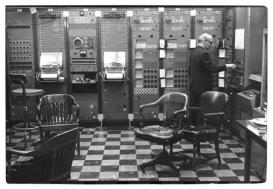“Liberal Sound” considers the impact of a man and a machine on Cold War musical modernism. The machine is the Mark II, RCA’s second programmable sound synthesizer—the first such device repurposed to support the esoteric work of “advanced” composers. The person is the composer Milton Babbitt, who regarded the Mark II as catalyst for developing a specialized community of elite, creative musicians and psychoacoustic researchers. The project explores various translations and transformations: from machine language to musical notation, from World War II military devices to Cold War sound synthesizers, and from the poetics of 1920s Viennese modernism to the ethos of Cold War American liberalism. The Mark II was created in RCA’s Sarnoff Laboratories in the mid-1950s and moved to Columbia University’s Columbia-Princeton Electronic Music Center in 1957 with funding from the Rockefeller Foundation. For Babbitt, the advent of a hybrid instrument comprising analog synthesis modules and digital programming instructions signaled a “revolution in musical sound.” In promoting this revolution, Babbitt recast Schoenberg’s rationale for emancipating dissonance, rejecting the Viennese composer’s ideas about evolutionary musical development in favor of an epistemology based on logical positivism, musical pluralism, and incommensurable structures. Electroacoustic synthesis not only instigated a postwar research and development program in music, but also affirmed the liberal-cosmopolitan ethics characteristic of American cultural cold warriors of Babbitt’s generation.

Milton Babbitt and the Mark II RCA Synthesizer, 1955. Source: Columbia-Princeton Electronic Music Center.
Project
(2018)
